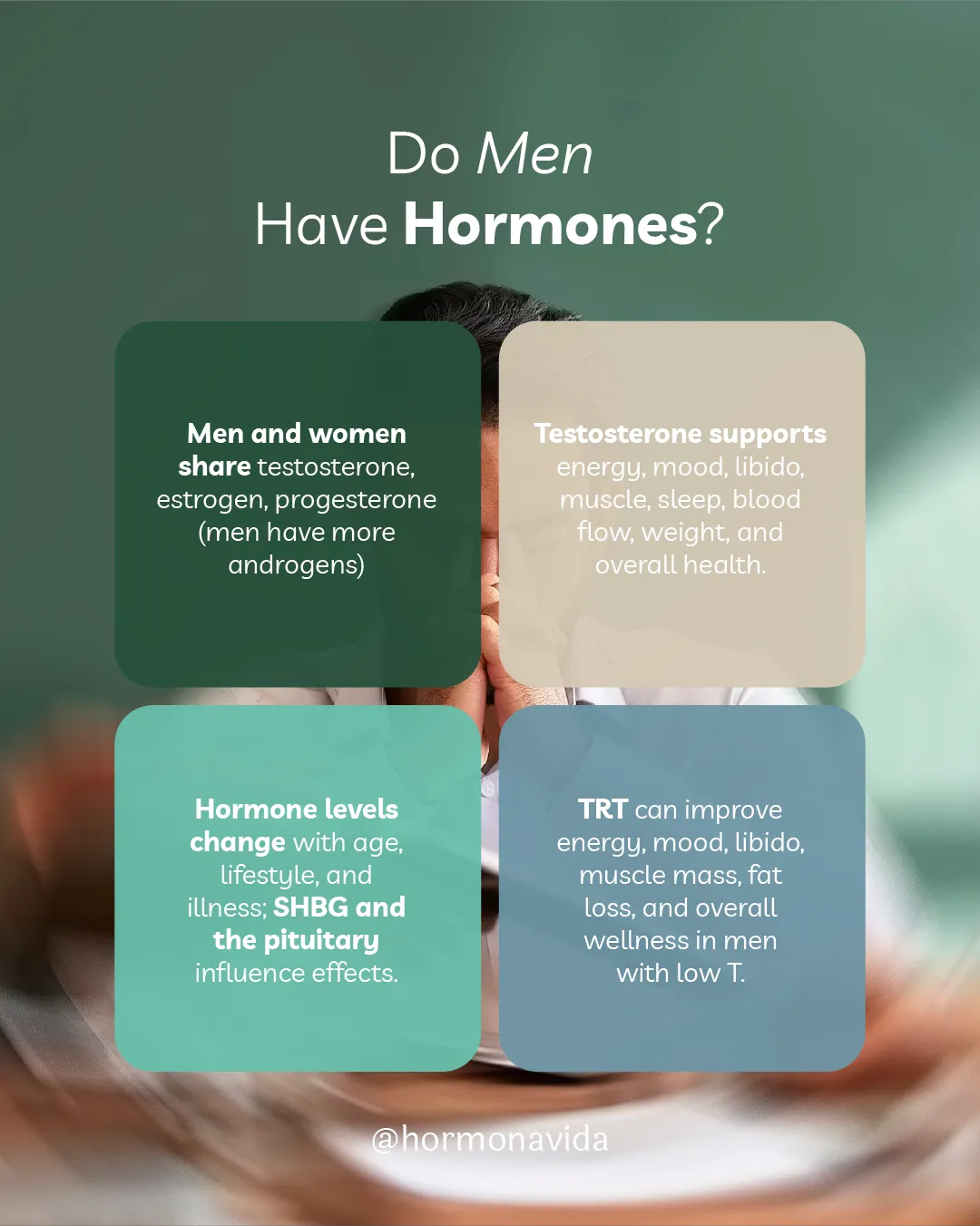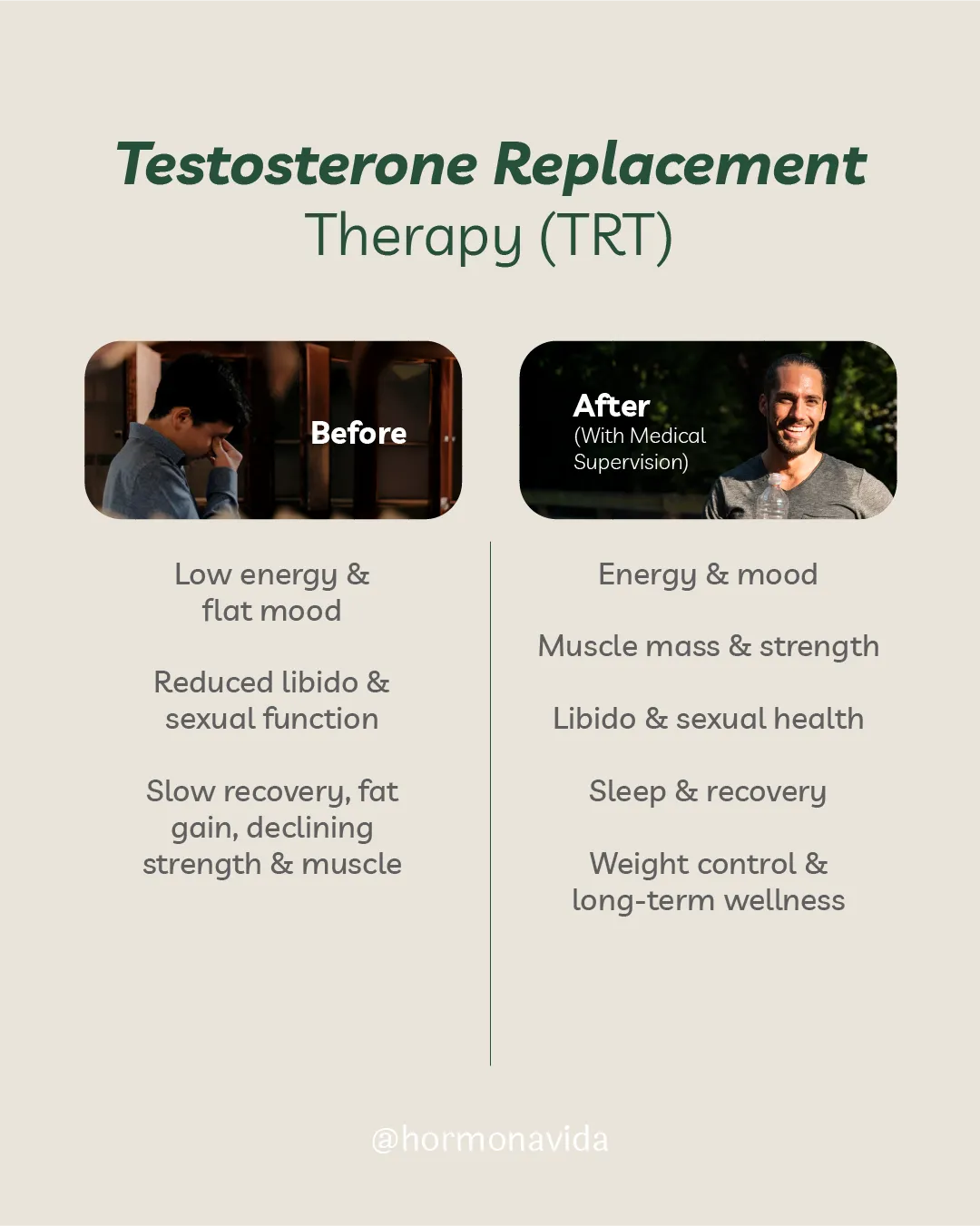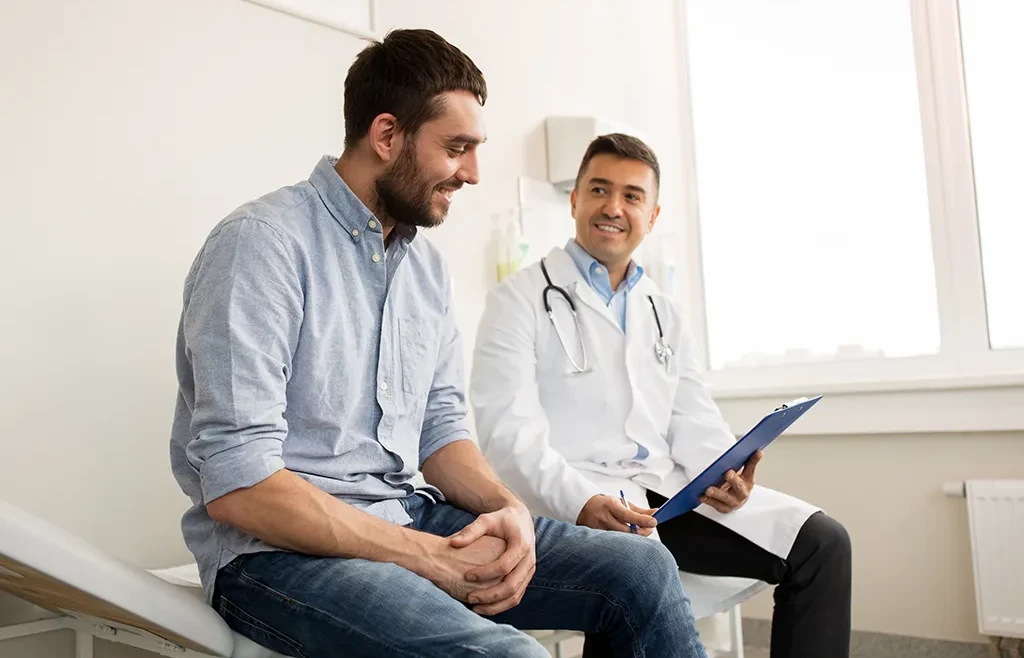Do Men Have Hormones? Facts, Tests & TRT
Men and women share the same main hormones: testosterone, estrogen, and progesterone. The amounts differ. In men, male sex hormones (androgens) are higher.
Testosterone leads many male characteristics, supports muscle mass, sex drive (libido), mood, blood flow, and red blood cells. Hormones also affect sleep, weight control, and long-term health.
Levels change with age, daily habits, and illness. Knowing your testosterone level and overall hormone levels helps with prevention, performance, and healthy aging.
This guide explains what is similar and different between men and women, how hormones work in men, when testosterone replacement therapy is useful, and what to expect before and after treatment. It also explains how sex hormone binding globulin SHBG and the pituitary gland influence what you feel.

What hormones do women have that men don’t?
In routine physiology, men and women share the same core hormones: testosterone, estrogen, and progesterone, but in different proportions. Men convert some testosterone to estradiol (a form of estrogen), which supports bone, brain, and sexual function. Women produce higher, cyclic estrogen and progesterone; men produce lower, steadier amounts.
The assertion that men lack so-called “female” hormones is incorrect. Men produce small amounts of estrogen and progesterone, and women produce small amounts of testosterone. Exceptions relate to pregnancy: hormones such as hCG and elevated prolactin occur in pregnancy or postpartum and are not typical of male biology.
Some conditions are sex-specific because of anatomy rather than unique hormones. Polycystic ovary syndrome PCOS affects women due to ovarian androgen excess; men do not have ovaries, so PCOS does not occur in males. By contrast, men face prostate conditions influenced by androgens, including benign enlargement and prostate cancer risk. In summary, differences arise from hormonal levels and reproductive organs not from distinct sets of chemicals.
How do hormones affect men?
Testosterone and day-to-day function
During puberty, testosterone drives classic male characteristics. The voice deepens. Facial and body hair grow. Genitals mature. Muscle mass rises.
In adult life, testosterone supports sex drive (libido), erectile quality, sperm production, bone strength, and the growth of red blood cells. It also shapes body composition by helping build lean mass and reduce visceral fat when levels sit in a healthy range.
The brain–testes control
The pituitary gland sends LH and FSH to the testes. These signals tell the testes to make testosterone and sperm. If the pituitary sends weak signals, or the testes cannot respond, testosterone level drops. A good workup looks for root causes such as poor sleep, sleep apnea, excess weight, certain drugs, or disorders of the testes or the pituitary gland.
SHBG and “usable” testosterone
Not all testosterone is active. Sex hormone binding globulin SHBG binds sex hormones in the blood. When SHBG is high, the free (usable) amount of testosterone falls.
A man may have a normal total level but low free testosterone and still feel low-T symptoms. Many clinicians order total T and SHBG (and albumin) to calculate free testosterone. That value better reflects what tissues receive.
Beyond testosterone
The body converts some testosterone to DHT. DHT affects hair and the prostate. Sensitivity to DHT contributes to male pattern baldness and prostate growth. Estradiol (from testosterone) supports libido, erection physiology, and bone strength.
Too little or too much estradiol can affect mood and sexual function. Thyroid hormones and cortisol also shape energy, stress response, and weight control. Because several signals overlap, a narrow focus on total T can miss the full picture.
Common signs of imbalance
When hormone levels are low, men may notice reduced sex drive (libido), erectile dysfunction, fatigue, low mood, and trouble focusing. Muscle mass can fall. Central fat can rise.
Training response can slow. Some men develop mild anemia because of fewer red blood cells. Bone density can decline over time. A morning blood test can measure total and free testosterone, SHBG, LH/FSH, thyroid markers, prolactin, and other labs to find the cause.
hormone replacement therapy (HRT) for men
In men, HRT most often means testosterone replacement therapy (TRT). Doctors consider TRT when symptoms fit and repeated morning tests show low values. The evaluation usually includes LH/FSH to separate testicular from central causes. It also includes a prostate check (exam and PSA) and a review of sleep, weight, alcohol, medicines, and other illnesses.
Potential benefits when levels are truly low
- Stronger sex drive (libido) and better erectile function, often with other ED care when needed.
- Improvements in mood, motivation, and cognitive focus.
- Increases in muscle mass and strength, better training response, and less visceral fat.
- Gains in bone density over months, which reduce fracture risk.
- Correction of anemia linked to low T, through higher red blood cells.
Risks and monitoring
TRT can raise hematocrit (too many red blood cells, also called erythrocytosis). Doctors track a complete blood count at set times. Some men get acne or oily skin. Mild fluid retention can occur.
External testosterone can lower sperm production. Because of this, TRT does not suit men who are trying to conceive unless a specialist adds a fertility-preserving plan.
Clinicians avoid TRT in men with prostate cancer. They also use care in men with strong urinary symptoms. Sleep apnea, advanced heart failure, and clotting disorders may prevent use or call for specialist input.
The aim is not “superhuman” levels. The goal is a healthy testosterone level in the middle of the normal range.
Testosterone Replacement Therapy before and after
Before
Men with confirmed low T often report low energy, flat mood, reduced sex drive (libido), erectile dysfunction, slow recovery after workouts, and stubborn fat gain. Strength stalls. Muscle mass declines. Motivation drops.
Labs can show low total and/or free T, sometimes with high SHBG. Some men show mild anemia or lower bone density.
After (with medical supervision)
Within weeks to months, many men feel steadier energy and better mood. Interest in intimacy returns. Morning erections often improve when low T was part of the cause.
Training becomes more productive. Lean mass rises. Fat falls. Strength returns. Results are best when TRT pairs with resistance training, protein-forward nutrition, good sleep, and stress control. Bone density improves over longer periods.
Follow-ups track symptoms, testosterone level, SHBG, hematocrit (red blood cells), and PSA. The care team adjusts dose and schedule as needed to improve outcomes and safety.
Set the right expectations. TRT does not fix problems that are not hormonal, such as severe vascular ED or uncontrolled diabetes. It can still help as part of a full plan. Results vary with dose, adherence, baseline health, and lifestyle.

FAQs
Do men produce estrogen and progesterone?
Yes, at lower levels than women. Estradiol (from testosterone) and small amounts of progesterone support bones, libido, and hormone balance in men and women.
Is there a clinically defined “male menopause”?
Not like female menopause. Men experience a gradual androgen decline, sometimes called male menopause or andropause, but it’s slow and variable.
Can low testosterone cause erectile dysfunction and low libido?
It can contribute to both. Addressing low testosterone often raises sex drive (libido) and can help erectile dysfunction. Vascular and psychological factors remain important.
How is low testosterone correctly tested?
Start with a morning blood test for total testosterone. Add free testosterone (or a calculation using sex hormone binding globulin SHBG), LH/FSH, and any other required tests. Repeat testing when indicated.
What is the clinical perspective on “men testosterone boosters”?
Lifestyle is foundational: resistance training, sleep, stress control, healthy weight, and adequate protein/fats support men’s testosterone balance. Use supplements only with clinician advice.
The Bottom Line, do men have hormones?
Men are absolutely hormonal and hormones matter. Managing hormone levels supports vitality, muscle mass, mood, sexual health, and healthy aging. If symptoms suggest low T, a structured evaluation and, where appropriate, carefully monitored testosterone replacement therapy can restore function. Balance is the target for every male hormone.
References
- Bhasin, S., et al. (2018). Testosterone therapy in men with hypogonadism: An Endocrine Society clinical practice guideline. Journal of Clinical Endocrinology & Metabolism, 103(5), 1715–1744. doi:10.1210/jc.2018-00229
- Cleveland Clinic. (2022, September 2). Low Testosterone (Male Hypogonadism).
- Cleveland Clinic. (2022, December 20). DHT (Dihydrotestosterone).
- Mayo Clinic Staff. (2025, March 26). Male menopause: Myth or reality? Mayo Clinic.
- Myers, A. (2025, June 27). Everyone Has Male and Female Hormones. AmyMyersMD.
- Rush, T. (2024, December 18). What to know about estrogen in men. Medical News Today.




